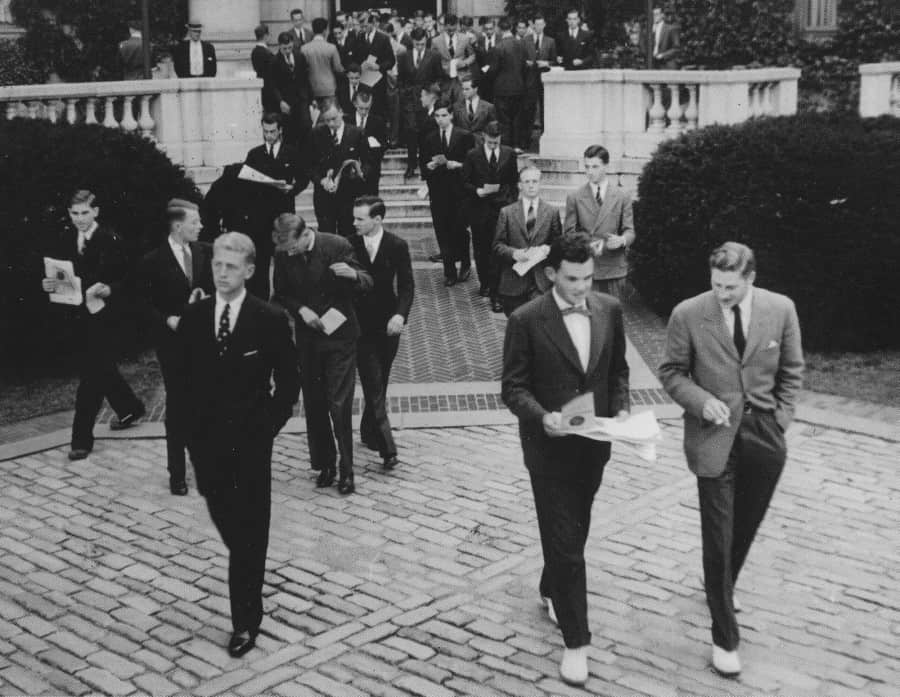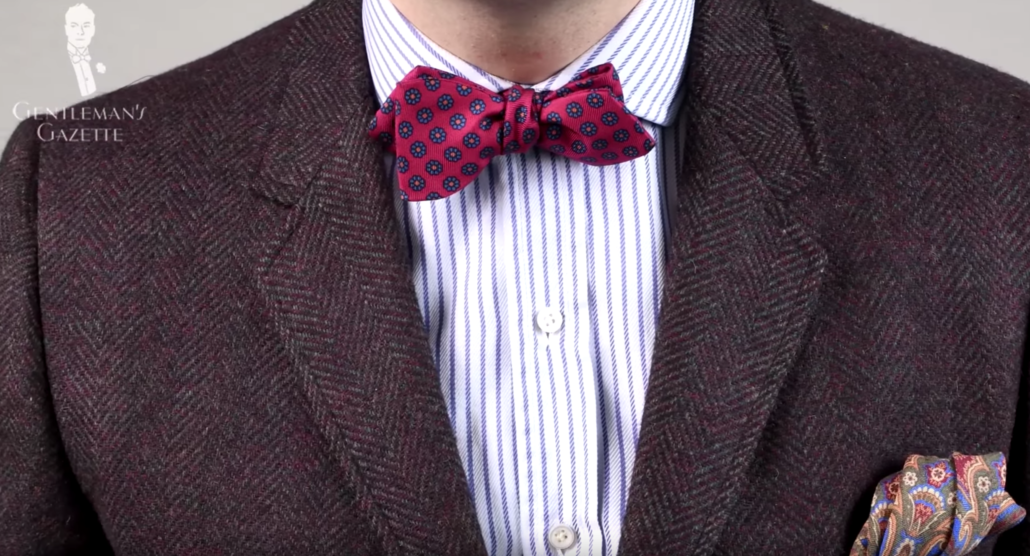
Yale students in more formal Ivy attire
For many, the Ivy, Prep, and Trad styles tend to blend together in a way that makes it difficult to differentiate them from one another.
We’ve discussed preppy style in detail and in this primer, we’re going to focus on the Ivy style, which unbeknownst to most, is actually a style of its own, separate and apart from prep and trad.
Of course, there are many similarities, but in most cases, it’s not so much the clothing, but how they’re worn.
The prep look is far more nautical in appearance, more beach appropriate and an ideal style for the Hamptons and Cape Cod. Ivy style, on the other hand, is a dressier version of prep that’s ideal for the historic chambers in the hallowed walls of America’s Ivy League schools like Harvard, Princeton, and Yale.
While the preppy style has been around since the early 1900s, first making an appearance around 1910, the ivy style really began to flourish in the early to mid-1950s on the grounds of the top universities and colleges in America. Just as prep style influenced many designers, ivy style took its fair share of the credit leading us to use the terms prep, ivy, and trad as synonyms of one another. Blended over the years, Ivy style was born out of an interest in appearing more elegant and well dressed than the casual undertones of the prep culture.
While prep style was reserved for garden parties, sailing, and casual affairs, Ivy style was for more formal, casual occasions such as attending class at Harvard Law, going on a late dinner date with the young lady you met at the Square or an event your parents insisted you attend with them at the country club after giving you a stern warning to leave the boat shoes and anchor bracelets at home.
The style was a direct reflection of college life at the campuses only the most affluent and well-versed students could attend. It separated the men of Harvard and Yale from the common youth at other colleges, and especially in a town like Cambridge where there are more colleges than shopping malls, the Ivy style became a way to instantly recognize a member of your social circle. That is until the style caught on and began to rise in popularity amongst all young men and women throughout the Northeastern United States.
Despite the students of the Ivy League schools knowing the style as “Ivy”, the rest of the world simply adopted it as a more formal version of prep and thus the blending of the styles was introduced. It is only the rarest of gentlemen that can pinpoint the differences between the various styles but is something we’ll attempt to explain.
Ivy style is about two things. Representing yourself through your wardrobe as a member of one of the most elite universities or colleges in the world and dressing down when the authority figure such as your father would normally dress up.
It’s really that simple. Slightly more formal, yet still relatively casual. Of course, today the styles are intertwined like vines along an old rusted fence and ivy style as its own subculture fell from existence in the late 1960s. Today the only separation between the two is the varying degree of formality, yet even that is too close to distinguish.
Christian Chensvold of Ivy-Style.com makes the perfect analogy. He says, “In 1964, when a spirited girl meets a handsome, reserved, all-American, clean-cut kind of guy who gets his clothing at Brooks Brothers and simultaneously finds herself both attracted and repelled by him, she teasingly calls him ‘Ivy League.’”
“And in 1970”, he says, “after the fall of the Ivy League Look when this same spirited girl meets the same all-American guy, she mockingly calls him ‘preppy.’”
“So you see”, remarks Chensvold, “the clothing is essentially the same. It’s just how women referred to the clothing — and the men who wore it.”
Today, the only difference comes down to semantics. True Ivy Leaguers will opt for penny loafers, Preps will choose boat shoes. A Prep will wear pants and shoes without socks. Conversely, Ivy Leaguers will only do so in the heat of summer. A Prep will almost never wear a suit and usually opt for a navy blazer instead. An Ivy Leaguer – while he loves the blazer – will still wear a suit almost half of the time.
When it comes to Prep, it’s about convenience, comfort, and style. For the Ivy Leaguer, it’s about style followed by comfort and then convenience. A Prep will throw on the first polo shirt he finds in his closet and pairs it with GTH pants. An Ivy Leaguer will take the time to put it under a cricket sweater and wear linen pants in eggshell.
When it comes to sports and lifestyle, both Prep and Ivy styles intertwine completely. Polo, tennis, and golf remain favorites and a weekend in Southampton is considered a sublime way to spend the summer. Winters are spent in Palm Beach, and there’s nothing better than spending a warm afternoon sipping G&Ts on a sailboat.
Of course with blended styles, the same clothiers occupied both the preppy style industry and the Ivy style industry. The most popular for Ivy Style was J.Press followed closely by Brooks Brothers, both of which were instrumental in the development of the mingled style we know it as today.
Of course, with Ivy style being so closely related to prep, we urge you to read our Preppy Style Guide by clicking here for the most iconic clothing. However, let’s examine some style staples we would find in Ivy Style pre-1967.
Introduced in 1936 by the G.H. Bass shoe company, penny loafers became an instant hit amongst the wealthy undergrads at Ivy League Schools in the United States. The ease of slipping them on combined with the formality of leather and suede made it the perfect compliment to a formal and yet very casual wardrobe. Read more about the penny loafer by clicking here.
Also called chinos, these are generally made from 100% cotton and despite being worn today by many retail stores and trades workers as uniforms, also work very well to compliment a blazer or with a sweater and tie. Available from numerous merchants, the classic chinos come from Brooks Brothers and are designed as a pair of business casual trousers perfect for a variety of events. They’re especially comfortable to wear in the summer as they breathe nicely, but they also work well due to their sturdier construction when compared to dress slacks.
Made from silk and wool, knit ties are a great way to fit into a more formal business environment while displaying a certain amount of sprezzatura and casualness. Their luxurious feel and cri de la soie texture make them a style staple for future corporate raiders, oil barons and media moguls that are still grasping onto their youth. Click here to see a selection of the finest knit ties from Fort Belvedere.
The herringbone jacket is a perfect way to turn what could otherwise be a more formal jacket into something casual without a wild pattern. With its country appeal, it became very popular for wear by those who frequented or took part in equestrian events. It was the jacket to use when you wanted to dress up for a date on the town but without looking like you were attending a funeral. With flap pockets and larger buttons to increase its casual tone, it has been and still remains a staple in ivy style. Today, it works very well with a pair of boots, an oxford cloth button-down shirt and corduroy pants.

Tweed sport coat with green and purple herringbone tones paired with Fort Belvedere accessories
Almost a homage to avoiding anything worn by your father, the two button cuff jacket became the standard worn by the Ivy League crowd. As if intended to piss off the older generation, it’s still worn today by Ivy Leaguers and is a great way for anyone to turn a formal jacket into leisurewear.
School sweaters are usually reserved these days for the cheerleading team, but back in the 1950s, men would wear these knit sweaters boasting their School’s letter in the center of the sweater. Not necessarily popular today, it was a standard amongst men on game days both on and off campus as a show of support for their school.
Here are a few of our favorite books on Ivy Style.
An authority on preppy style, Jeffrey Banks focuses on the style that helped shape what we know today as Prep. Taking us back to the Ivy League campuses of the fifties, this incredible book shows us the most fashionable ivy league style staples from its heyday. Click here to get a copy.
A look into the styles of the most prestigious college campuses in the mid 20th century, Mears introduces us to what was pinnacle of classic preppy fashion. A great read filled with insights and history, you can get your own copy by clicking here or read our review here.
While it discusses the style, this book focuses on everything Ivy League related. From the private clubs to the classroom, it’s a really fantastic read if you’re interested in the schools and the lifestyle but never had the chance to attend. Click here for your copy.
“Democratic, stylish and comfortable”, The Ivy Look is literally a pocket guide to everything Ivy Style. Focused on life before the preppy style, it showcases what it meant to be a member of the Ivy League in the early 1950s to mid-1960s. It’s an interesting book but one that tends to tread slightly outside of the Ivy Style focusing on celebrities who attempted to replicate parts of it. Click here for your own pocket guide.
Described by The New York Times as, “a treasure of fashion insiders,” Take Ivy is a look at the classic Ivy Style and how the American fashion influenced Japan. An archive of photographs serves as its road map to discussing the trend that swept the nation and then jumped the pond. Click here for your own copy.
Hopefully, this has given you a glimpse into the minor differences between Preppy style and Ivy League style. Obviously, there aren’t many and it’s very difficult to differentiate the two; especially when designers, the media, and the general public all classify them as one in the same.
Labels: Gentleman's Gazette